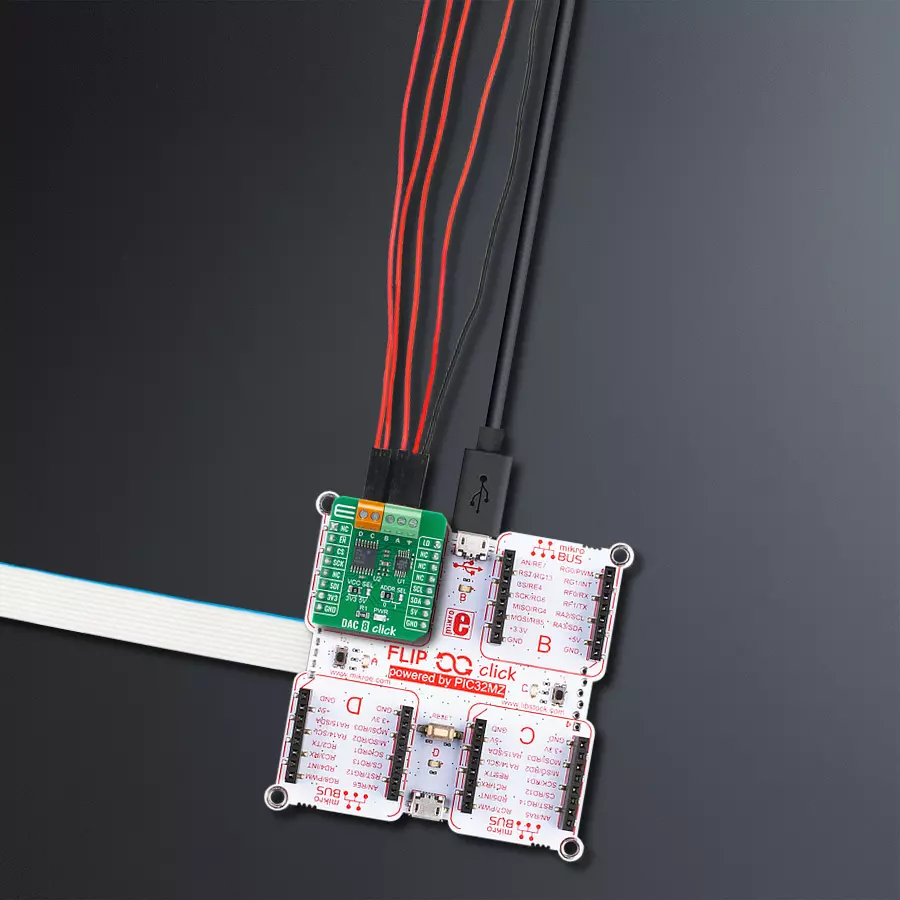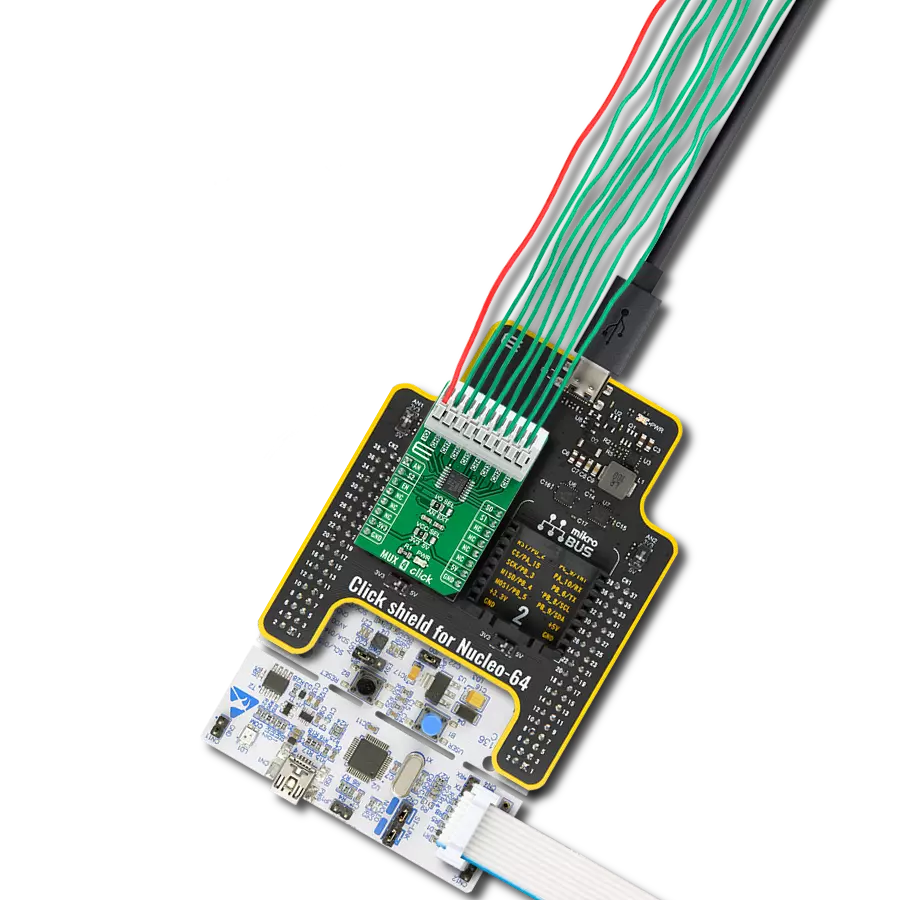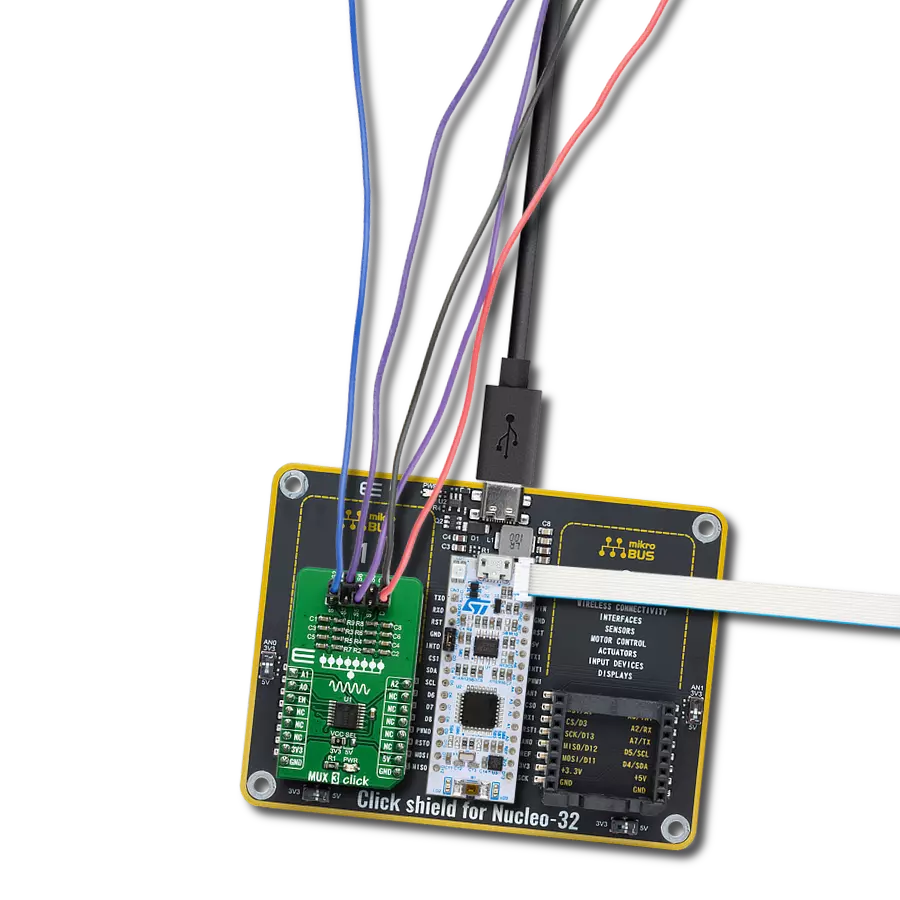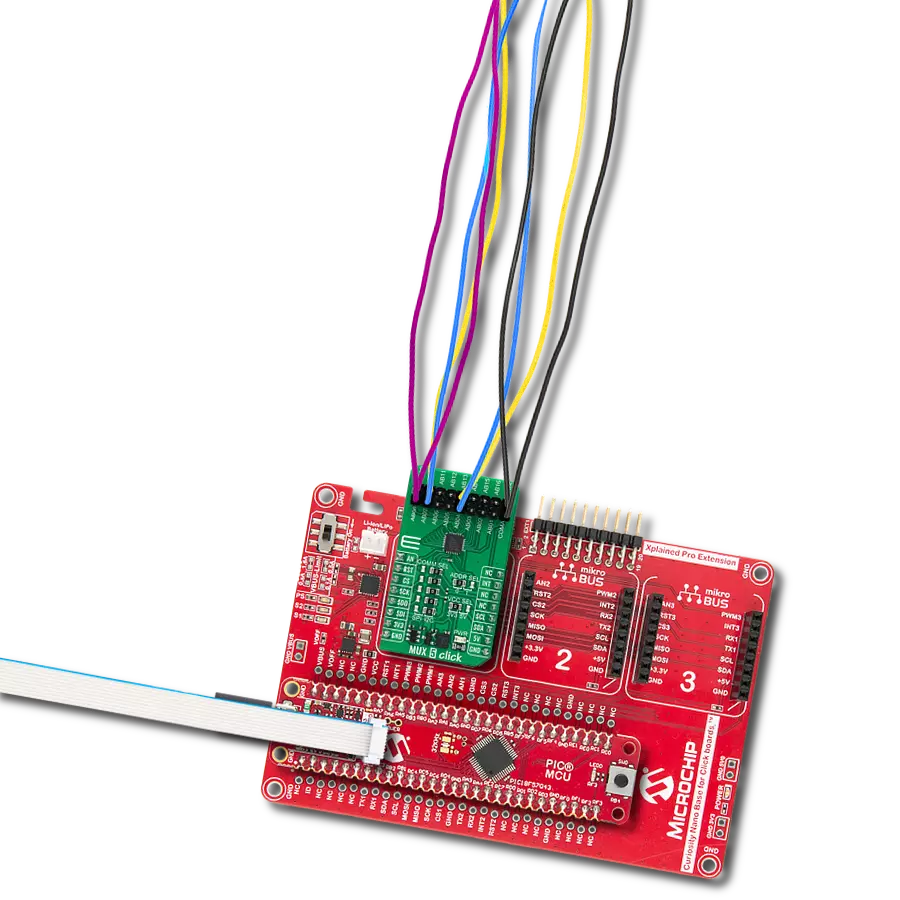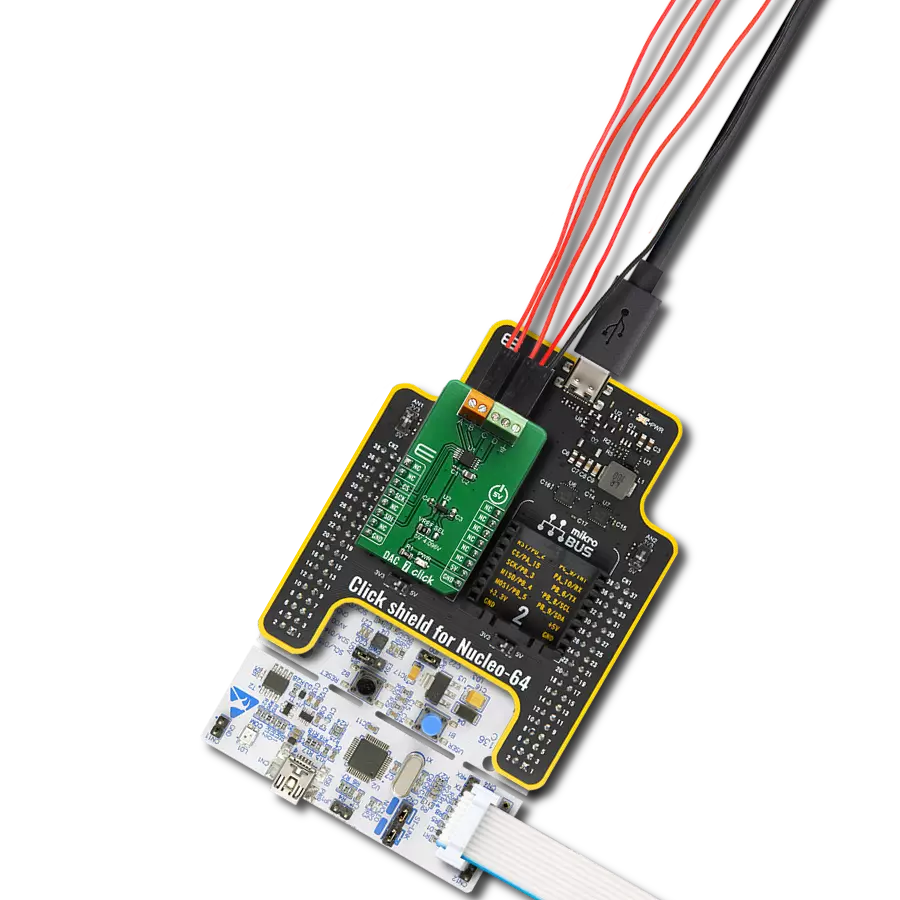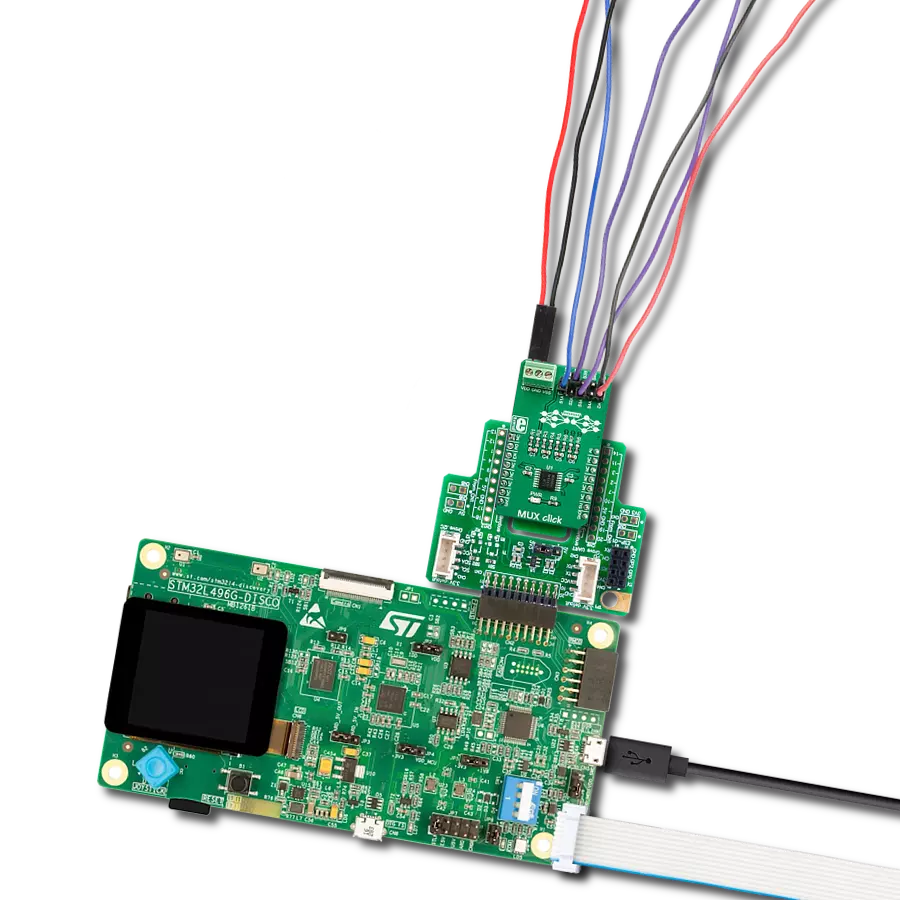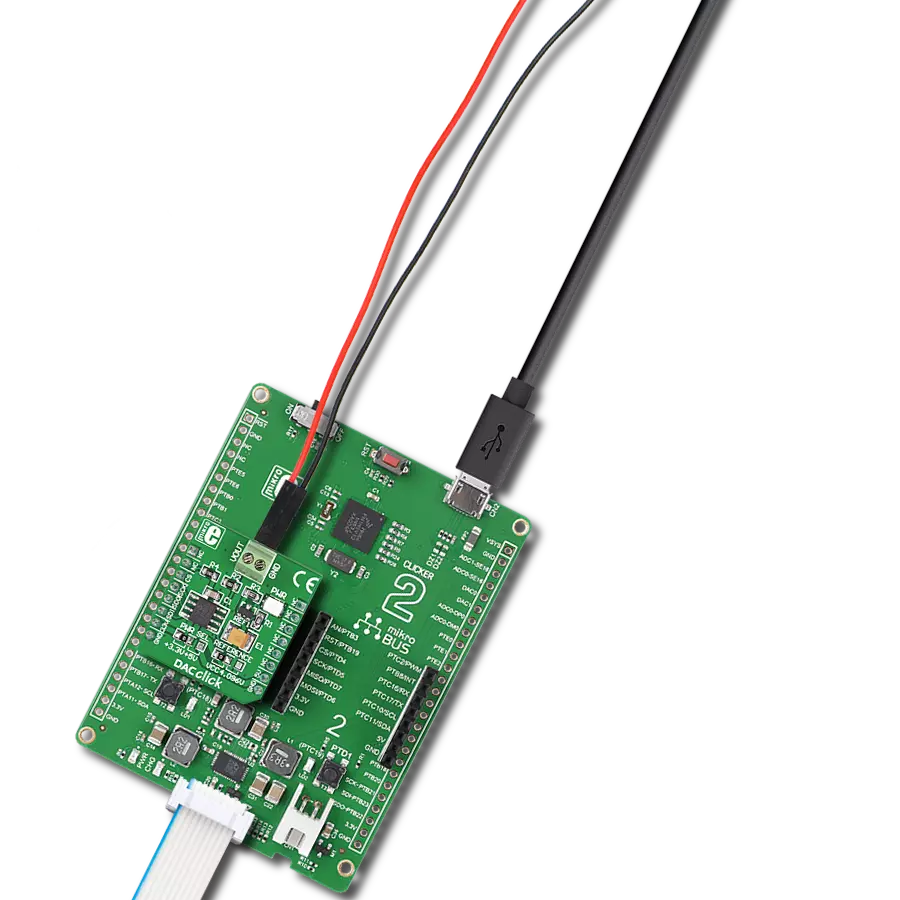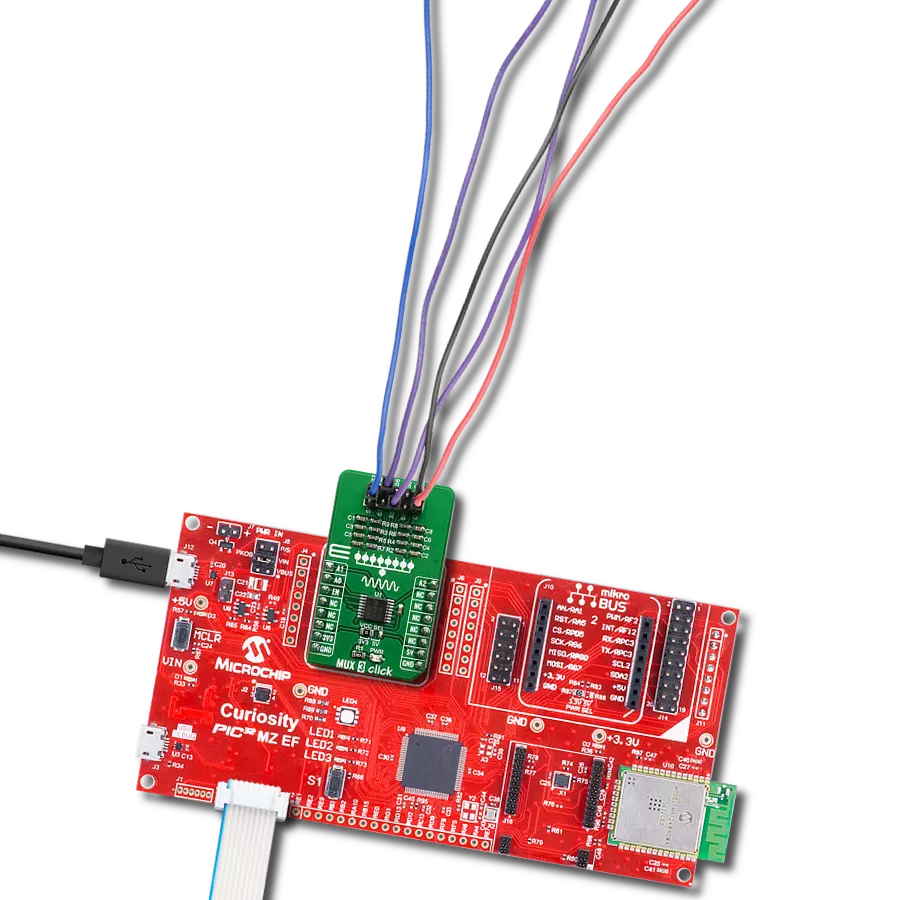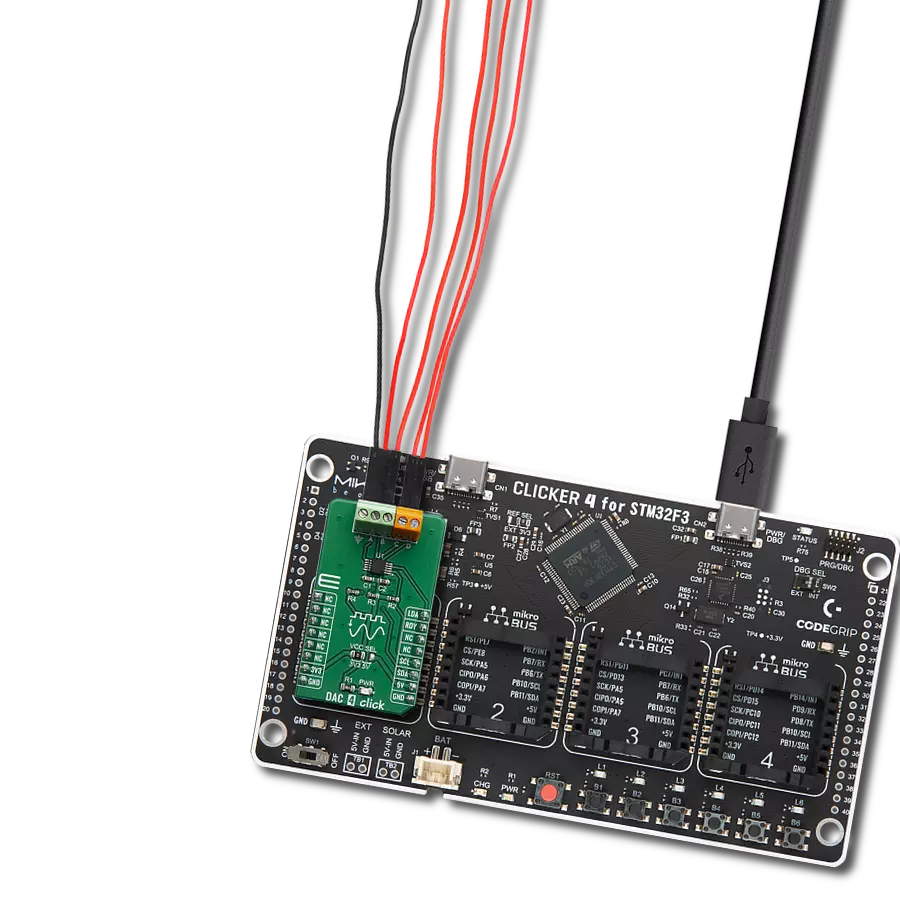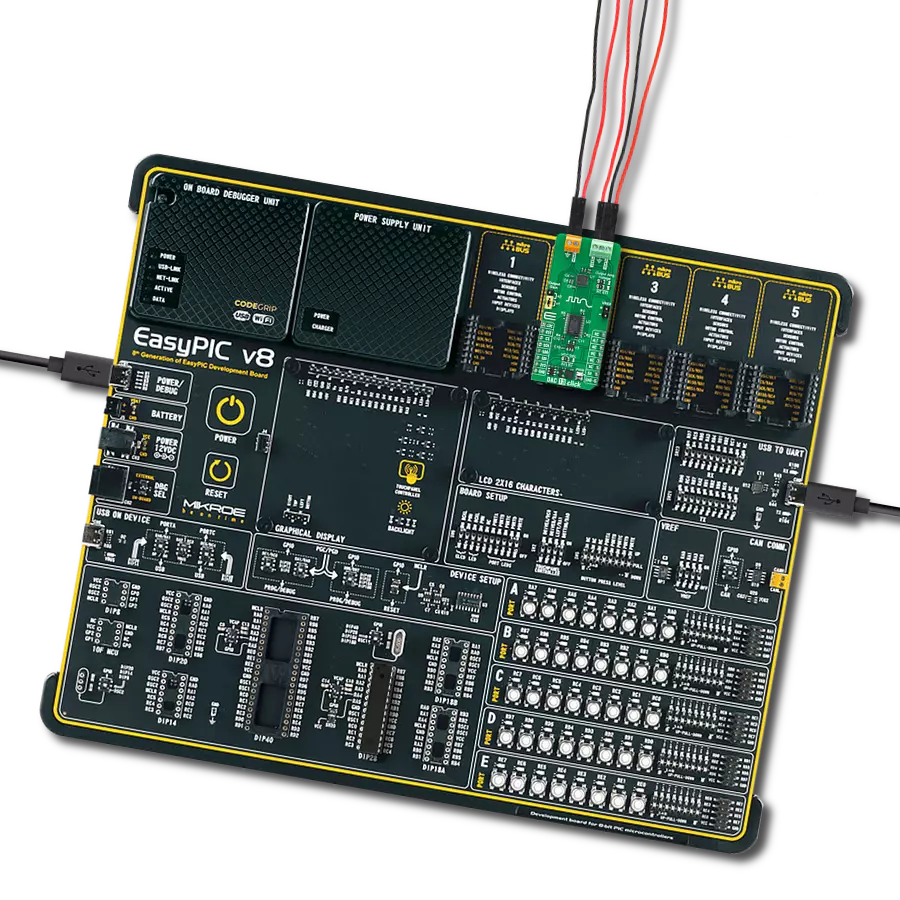Experience the synergy of precision and transformation with our DAC solution
A
A
Hardware Overview
How does it work?
DAC 8 Click is based on the DAC8554IPWR, a 16-bit QUAD channel, ultra-low glitch, voltage-output digital to analog converter from Texas Instruments. It offers good linearity, exceptionally low glitch, and it has high precision output amplifier that allows rail-to-rail output swing over a wide range of supply voltage. What this component additionally has is a Power-On reset function, which ensures that DAC outputs power-up at zero-scale and remains there until a proper write operation occurs. Also, it provides a power-down feature that reduces the current consumption to 175nA per channel. To achieve a fully flexible range of the DAC8554IPWR, an external voltage reference is made user-programmable. For this purpose, the Click board™ uses another DAC, DAC60501MDGSR, 12-bit DAC from Texas Instruments, whose output is brought to
the VREF pin of the DAC8554IPWR. That way, the reference voltage of the DAC8554IPWR can be set at any value between 0V and 5V, provides high precision and low power consumption as well. That makes the DAC 8 Click fully customizable solution, well suited for applications where the maximum precision from the output 16-bit DAC is needed. DAC60501MDGSR uses the I2C serial interface to communicate with the MCU and operates at clock rate up to 100kHz, with selectable I2C address through ADDR SEL jumper. The DAC 6 Click communicates with MCU using the 3-Wire SPI serial interface that is compatible with standard SPI, QSPI™, MICROWIRE™ and operates at clock rates up to 50 MHz. Additional functionality such as software simultaneous update capability is implemented and routed at the PWM pin of the
mikroBUS™, which allows when new data enter the device, all of DAC outputs can be updated simultaneously and synchronously with the clock. It also possesses enable function routed at CS pin of the mikroBUS™ that is used to connect the SPI interface to the serial port. This Click Board™ is designed to be operated with both 3.3V and 5V logic levels. The onboard SMD jumper labeled as VCC SEL allows voltage selection for interfacing with both 3.3V and 5V MCUs. More information about the DAC8554IPWR’s functionality, electrical specifications, and typical performance can be found in the attached datasheet. However, the Click board™ comes equipped with a library that contains easy-to-use functions, and a usage example that can be used as a reference for the development.
Features overview
Development board
Flip&Click PIC32MZ is a compact development board designed as a complete solution that brings the flexibility of add-on Click boards™ to your favorite microcontroller, making it a perfect starter kit for implementing your ideas. It comes with an onboard 32-bit PIC32MZ microcontroller, the PIC32MZ2048EFH100 from Microchip, four mikroBUS™ sockets for Click board™ connectivity, two USB connectors, LED indicators, buttons, debugger/programmer connectors, and two headers compatible with Arduino-UNO pinout. Thanks to innovative manufacturing technology,
it allows you to build gadgets with unique functionalities and features quickly. Each part of the Flip&Click PIC32MZ development kit contains the components necessary for the most efficient operation of the same board. In addition, there is the possibility of choosing the Flip&Click PIC32MZ programming method, using the chipKIT bootloader (Arduino-style development environment) or our USB HID bootloader using mikroC, mikroBasic, and mikroPascal for PIC32. This kit includes a clean and regulated power supply block through the USB Type-C (USB-C) connector. All communication
methods that mikroBUS™ itself supports are on this board, including the well-established mikroBUS™ socket, user-configurable buttons, and LED indicators. Flip&Click PIC32MZ development kit allows you to create a new application in minutes. Natively supported by Mikroe software tools, it covers many aspects of prototyping thanks to a considerable number of different Click boards™ (over a thousand boards), the number of which is growing every day.
Microcontroller Overview
MCU Card / MCU
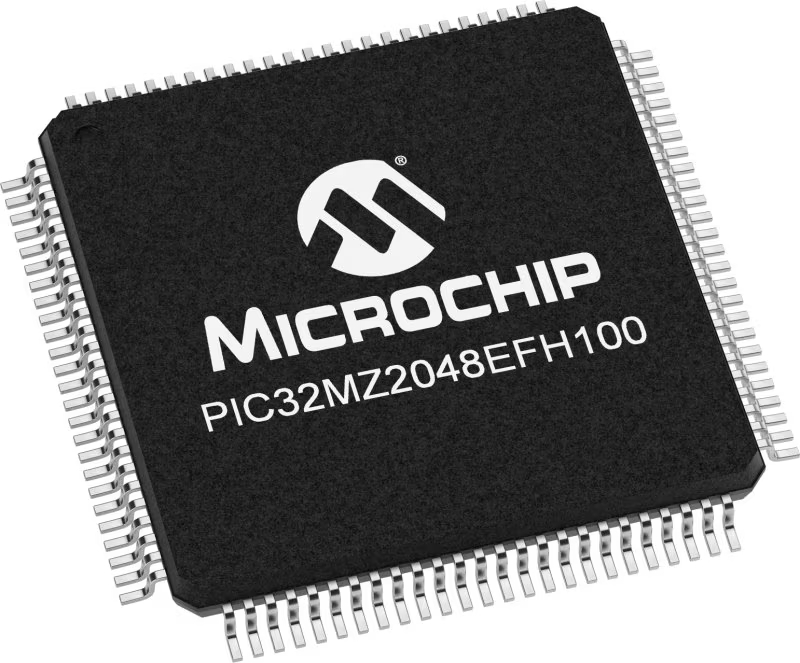
Architecture
PIC32
MCU Memory (KB)
2048
Silicon Vendor
Microchip
Pin count
100
RAM (Bytes)
524288
Used MCU Pins
mikroBUS™ mapper
Take a closer look
Click board™ Schematic

Step by step
Project assembly
Software Support
Library Description
DAC 8 Click demo application is developed using the NECTO Studio, ensuring compatibility with mikroSDK's open-source libraries and tools. Designed for plug-and-play implementation and testing, the demo is fully compatible with all development, starter, and mikromedia boards featuring a mikroBUS™ socket.
Example Description
This Click carries 12-bit buffered Digital-to-Analog Converter. It converts digital value to the corresponding voltage level using external voltage reference.
Key functions:
dac8_cfg_setup- Config Object Initialization function.dac8_init- Initialization function.dac8_device_config- Output digital-to-analog converter on DAC 8 Click board.dac8_load_dac- Buffers of all channels must be loaded with desired data before call Load DAC function.dac8_set_vref- With Precision Internal Reference on DAC 8 Click board.
Application Init
Initialization driver enables - I2C. Configure DAC60501: executes call software reset, disable sync and internal reference and disable Power-down mode, the set reference voltage is internally divided by a factor of 2, amplifier for corresponding DAC has a gain of 2. Initialization driver enables - SPI, enable DAC8554, also write log.
Application Task
This is an example that demonstrates the use of the DAC 8 Click board. DAC 8 board changeing output values: Channel A ~ 2500 mV, Channel B ~ 1250 mV, Channel C ~ 625 mV, Channel D ~ 312 mV. All data logs write on USB uart changes every 5 sec.
Open Source
Code example
The complete application code and a ready-to-use project are available through the NECTO Studio Package Manager for direct installation in the NECTO Studio. The application code can also be found on the MIKROE GitHub account.
/*!
* \file
* \brief Dac8 Click example
*
* # Description
* This Click carries 12-bit buffered Digital-to-Analog Converter. It converts digital value to
* the corresponding voltage level using external voltage reference.
*
* The demo application is composed of two sections :
*
* ## Application Init
* Initialization driver enables - I2C.
* Configure DAC60501: executes call software reset, disable sync and internal reference and
* disable Power-down mode, the set reference voltage is internally divided by a factor of 2,
* amplifier for corresponding DAC has a gain of 2.
* Initialization driver enables - SPI, enable DAC8554, also write log.
*
* ## Application Task
* This is an example that demonstrates the use of the DAC 8 Click board.
* DAC 8 board changeing output values:
* Channel A ~ 2500 mV, Channel B ~ 1250 mV,
* Channel C ~ 625 mV, Channel D ~ 312 mV.
* All data logs write on USB uart changes every 5 sec.
*
*
* \author MikroE Team
*
*/
// ------------------------------------------------------------------- INCLUDES
#include "board.h"
#include "log.h"
#include "dac8.h"
// ------------------------------------------------------------------ VARIABLES
static dac8_t dac8;
static log_t logger;
dac8_cfg_data_t cfg_dac;
// ------------------------------------------------------ APPLICATION FUNCTIONS
void application_init ( void )
{
log_cfg_t log_cfg;
dac8_cfg_t cfg;
/**
* Logger initialization.
* Default baud rate: 115200
* Default log level: LOG_LEVEL_DEBUG
* @note If USB_UART_RX and USB_UART_TX
* are defined as HAL_PIN_NC, you will
* need to define them manually for log to work.
* See @b LOG_MAP_USB_UART macro definition for detailed explanation.
*/
LOG_MAP_USB_UART( log_cfg );
log_init( &logger, &log_cfg );
log_info( &logger, "---- Application Init ----" );
// Click initialization.
dac8_cfg_setup( &cfg );
DAC8_MAP_MIKROBUS( cfg, MIKROBUS_1 );
dac8_init( &dac8, &cfg, DAC8_MASTER_I2C );
log_printf( &logger, "---------------------\r\n" );
log_printf( &logger, " I2C driver init. \r\n" );
Delay_ms ( 100 );
log_printf( &logger, "---------------------\r\n" );
log_printf( &logger, " DAC60501 \r\n" );
log_printf( &logger, "---------------------\r\n" );
log_printf( &logger, " Soft reset \r\n" );
dac8_soft_reset( &dac8 );
Delay_ms ( 100 );
log_printf( &logger, "---------------------\r\n" );
log_printf( &logger, " Disable sync. mode \r\n" );
dac8_enable_sync( &dac8, DAC8_SYNC_DISABLE );
Delay_ms ( 100 );
log_printf( &logger, "---------------------\r\n" );
log_printf( &logger, " Set config.: \r\n" );
log_printf( &logger, " Enable: \r\n" );
log_printf( &logger, " Internal reference \r\n" );
log_printf( &logger, " Disable: \r\n" );
log_printf( &logger, " Power-down mode \r\n" );
dac8_set_config( &dac8, DAC8_CONFIG_REF_PWDWN_ENABLE, DAC8_CONFIG_DAC_PWDWN_DISABLE );
Delay_ms ( 100 );
log_printf( &logger, "---------------------\r\n" );
log_printf( &logger, " Vref divided by 2 \r\n" );
log_printf( &logger, " Set DAC gain of 2 \r\n" );
dac8_set_gain( &dac8, DAC8_GAIN_REF_DIV_2, DAC8_GAIN_BUFF_GAIN_1 );
Delay_ms ( 100 );
log_printf( &logger, "---------------------\r\n" );
log_printf( &logger, " Set Vref ~ 2500 mV \r\n" );
dac8_set_vref( &dac8, 2500 );
Delay_ms ( 1000 );
dac8_init( &dac8, &cfg, DAC8_MASTER_SPI );
log_printf( &logger, "---------------------\r\n" );
log_printf( &logger, " SPI driver init. \r\n" );
Delay_ms ( 1000 );
log_printf( &logger, "---------------------\r\n" );
log_printf( &logger, " DAC8554 \r\n" );
log_printf( &logger, "---------------------\r\n" );
log_printf( &logger, " Enable DAC8554 \r\n" );
dac8_device_enable( &dac8, DAC8_DAC8554_ENABLE );
Delay_ms ( 100 );
}
void application_task ( void )
{
log_printf( &logger, "---------------------\r\n" );
cfg_dac.addr = DAC8_ADDR_DEFAULT;
cfg_dac.ctrl_upd_an_out = DAC8_CTRL_UPD_AN_OUT_SINGLE_CH_STORE;
cfg_dac.dac_sel = DAC8_DAC_SEL_CH_A;
cfg_dac.pwr_mode = DAC8_PWR_MODE_POWER_UP;
cfg_dac.dac_val = 0xFFFF;
log_printf( &logger, " Channel A ~ 2500 mV \r\n" );
dac8_device_config( &dac8, cfg_dac );
dac8_load_dac( &dac8 );
Delay_ms ( 1000 );
Delay_ms ( 1000 );
Delay_ms ( 1000 );
Delay_ms ( 1000 );
Delay_ms ( 1000 );
log_printf( &logger, "---------------------\r\n" );
cfg_dac.addr = DAC8_ADDR_DEFAULT;
cfg_dac.ctrl_upd_an_out = DAC8_CTRL_UPD_AN_OUT_SINGLE_CH_STORE;
cfg_dac.dac_sel = DAC8_DAC_SEL_CH_B;
cfg_dac.pwr_mode = DAC8_PWR_MODE_POWER_UP;
cfg_dac.dac_val = 0x7FFF;
log_printf( &logger, " Channel B ~ 1250 mV \r\n" );
dac8_device_config( &dac8, cfg_dac );
dac8_load_dac( &dac8 );
Delay_ms ( 1000 );
Delay_ms ( 1000 );
Delay_ms ( 1000 );
Delay_ms ( 1000 );
Delay_ms ( 1000 );
log_printf( &logger, "---------------------\r\n" );
cfg_dac.addr = DAC8_ADDR_DEFAULT;
cfg_dac.ctrl_upd_an_out = DAC8_CTRL_UPD_AN_OUT_SINGLE_CH_STORE;
cfg_dac.dac_sel = DAC8_DAC_SEL_CH_C;
cfg_dac.pwr_mode = DAC8_PWR_MODE_POWER_UP;
cfg_dac.dac_val = 0x3FFF;
log_printf( &logger, " Channel C ~ 625 mV \r\n" );
dac8_device_config( &dac8, cfg_dac );
dac8_load_dac( &dac8 );
Delay_ms ( 1000 );
Delay_ms ( 1000 );
Delay_ms ( 1000 );
Delay_ms ( 1000 );
Delay_ms ( 1000 );
log_printf( &logger, "---------------------\r\n" );
cfg_dac.addr = DAC8_ADDR_DEFAULT;
cfg_dac.ctrl_upd_an_out = DAC8_CTRL_UPD_AN_OUT_SINGLE_CH_STORE;
cfg_dac.dac_sel = DAC8_DAC_SEL_CH_D;
cfg_dac.pwr_mode = DAC8_PWR_MODE_POWER_UP;
cfg_dac.dac_val = 0x1FFF;
log_printf( &logger, " Channel D ~ 312 mV\r\n" );
dac8_device_config( &dac8, cfg_dac );
dac8_load_dac( &dac8 );
Delay_ms ( 1000 );
Delay_ms ( 1000 );
Delay_ms ( 1000 );
Delay_ms ( 1000 );
Delay_ms ( 1000 );
}
int main ( void )
{
/* Do not remove this line or clock might not be set correctly. */
#ifdef PREINIT_SUPPORTED
preinit();
#endif
application_init( );
for ( ; ; )
{
application_task( );
}
return 0;
}
// ------------------------------------------------------------------------ END
Additional Support
Resources
Category:DAC







